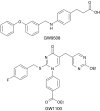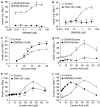Pharmacological regulation of insulin secretion in MIN6 cells through the fatty acid receptor GPR40: identification of agonist and antagonist small molecules
- PMID: 16702987
- PMCID: PMC1751878
- DOI: 10.1038/sj.bjp.0706770
Pharmacological regulation of insulin secretion in MIN6 cells through the fatty acid receptor GPR40: identification of agonist and antagonist small molecules
Abstract
1. Long chain fatty acids have recently been identified as agonists for the G protein-coupled receptors GPR40 and GPR120. Here, we present the first description of GW9508, a small-molecule agonist of the fatty acid receptors GPR40 and GPR120. In addition, we also describe the pharmacology of GW1100, a selective GPR40 antagonist. These molecules were used to further investigate the role of GPR40 in glucose-stimulated insulin secretion in the MIN6 mouse pancreatic beta-cell line. 2. GW9508 and linoleic acid both stimulated intracellular Ca2+ mobilization in human embryonic kidney (HEK)293 cells expressing GPR40 (pEC50 values of 7.32+/-0.03 and 5.65+/-0.06, respectively) or GPR120 (pEC50 values of 5.46+/-0.09 and 5.89+/-0.04, respectively), but not in the parent HEK-293 cell line. 3. GW1100 dose dependently inhibited GPR40-mediated Ca2+ elevations stimulated by GW9508 and linoleic acid (pIC50 values of 5.99+/-0.03 and 5.99+/-0.06, respectively). GW1100 had no effect on the GPR120-mediated stimulation of intracellular Ca2+ release produced by either GW9508 or linoleic acid. 4. GW9508 dose dependently potentiated glucose-stimulated insulin secretion in MIN6 cells, but not in primary rat or mouse islets. Furthermore, GW9508 was able to potentiate the KCl-mediated increase in insulin secretion in MIN6 cells. The effects of GW9508 on insulin secretion were reversed by GW1100, while linoleic acid-stimulated insulin secretion was partially attenuated by GW1100. 5. These results add further evidence to a link between GPR40 and the ability of fatty acids to acutely potentiate insulin secretion and demonstrate that small-molecule GPR40 agonists are glucose-sensitive insulin secretagogues.
Figures





Similar articles
-
Chronic activation of GPR40 does not negatively impact upon BRIN-BD11 pancreatic β-cell physiology and function.Pharmacol Rep. 2020 Dec;72(6):1725-1737. doi: 10.1007/s43440-020-00101-6. Epub 2020 Apr 9. Pharmacol Rep. 2020. PMID: 32274767 Free PMC article.
-
GW9508 inhibits insulin secretion by activating ATP-sensitive potassium channels in rat pancreatic β-cells.J Mol Endocrinol. 2013 Jun 1;51(1):69-77. doi: 10.1530/JME-13-0019. Print 2013. J Mol Endocrinol. 2013. PMID: 23628491
-
Evidence for the involvement of GPR40 and NADPH oxidase in palmitic acid-induced superoxide production and insulin secretion.Islets. 2013 Jul-Aug;5(4):139-48. doi: 10.4161/isl.25459. Epub 2013 Jun 28. Islets. 2013. PMID: 23817296
-
GPR120 agonists for the treatment of diabetes: a patent review (2014 present).Expert Opin Ther Pat. 2020 Oct;30(10):729-742. doi: 10.1080/13543776.2020.1811852. Epub 2020 Aug 30. Expert Opin Ther Pat. 2020. PMID: 32799609 Review.
-
Modulating GPR40: therapeutic promise and potential in diabetes.Drug Discov Today. 2013 Dec;18(23-24):1301-8. doi: 10.1016/j.drudis.2013.09.003. Epub 2013 Sep 16. Drug Discov Today. 2013. PMID: 24051395 Review.
Cited by
-
FFAR4: A New Player in Cardiometabolic Disease?Endocrinology. 2021 Aug 1;162(8):bqab111. doi: 10.1210/endocr/bqab111. Endocrinology. 2021. PMID: 34043793 Free PMC article. Review.
-
Dimethyl sulfoxide acutely enhances regulated insulin secretion in the MIN6-K8 mouse insulinoma cell line.Histochem Cell Biol. 2021 Jul;156(1):69-73. doi: 10.1007/s00418-021-01984-z. Epub 2021 Mar 20. Histochem Cell Biol. 2021. PMID: 33743067 Free PMC article.
-
GPR40 (FFAR1) - Combined Gs and Gq signaling in vitro is associated with robust incretin secretagogue action ex vivo and in vivo.Mol Metab. 2014 Oct 24;4(1):3-14. doi: 10.1016/j.molmet.2014.10.002. eCollection 2015 Jan. Mol Metab. 2014. PMID: 25685685 Free PMC article.
-
Palmitic Acid Reduces the Autophagic Flux and Insulin Sensitivity Through the Activation of the Free Fatty Acid Receptor 1 (FFAR1) in the Hypothalamic Neuronal Cell Line N43/5.Front Endocrinol (Lausanne). 2019 Mar 26;10:176. doi: 10.3389/fendo.2019.00176. eCollection 2019. Front Endocrinol (Lausanne). 2019. PMID: 30972025 Free PMC article.
-
Free fatty acid receptor 1: a ray of hope in the therapy of type 2 diabetes mellitus.Inflammopharmacology. 2021 Dec;29(6):1625-1639. doi: 10.1007/s10787-021-00879-8. Epub 2021 Oct 20. Inflammopharmacology. 2021. PMID: 34669065 Review.
References
-
- AMES R., NUTHULAGANTI P., FORNWALD J., SHABON U., VAN DER KEYL H., ELSHOURBAGY N. Heterologous expression of G protein-coupled receptors in U-2 OS osteosarcoma cells. Receptors Channels. 2004;10:117–124. - PubMed
-
- BLACK J.W., LEFF P. Operational models of pharmacological agonism. Proc. Roy. Soc. London – Ser. B: Biol. Sci. 1983;220:141–162. - PubMed
-
- BRISCOE C.P., TADAYYON M., ANDREWS J.L., BENSON W.G., CHAMBERS J.K., EILERT M.M., ELLIS C., ELSHOURBAGY N.A., GOETZ A.S., MINNICK D.T., MURDOCK P.R., SAULS H.R., SHABON U., SPINAGE L.D., STRUM J.C., SZEKERES P.G., TAN K.B., WAY J.M., IGNAR D.M., WILSON S., MUIR A.I. The orphan G protein-coupled receptor GPR40 is activated by medium and long chain fatty acids. J. Biol. Chem. 2003;278:11303–11311. - PubMed
-
- BROWN A.J., GOLDSWORTHY S.M., BARNES A.A., EILERT M.M., TCHEANG L., DANIELS D., MUIR A.I., WIGGLESWORTH M.J., KINGHORN I., FRASER N.J., PIKE N.B., STRUM J.C., STEPLEWSKI K.M., MURDOCK P.R., HOLDER J.C., MARSHALL F.H., SZEKERES P.G., WILSON S., IGNAR D.M., FOORD S.M., WISE A., DOWELL S.J. The orphan G protein-coupled receptors GPR41 and GPR43 are activated by propionate and other short chain carboxylic acids. J. Biol. Chem. 2003;278:11312–11319. - PubMed
-
- BROWN A.J., JUPE S., BRISCOE C.P. A family of fatty acid binding receptors. DNA Cell. Biol. 2005;24:54–61. - PubMed
Publication types
MeSH terms
Substances
LinkOut - more resources
Full Text Sources
Other Literature Sources
Medical
Molecular Biology Databases
Miscellaneous

